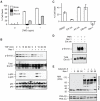RIP1-dependent and independent effects of necrostatin-1 in necrosis and T cell activation
- PMID: 21853090
- PMCID: PMC3154273
- DOI: 10.1371/journal.pone.0023209
RIP1-dependent and independent effects of necrostatin-1 in necrosis and T cell activation
Abstract
Background: Programmed necrosis/necroptosis is an emerging form of cell death that plays important roles in mammalian development and the immune system. The pro-necrotic kinases in the receptor interacting protein (RIP) family are crucial mediators of programmed necrosis. Recent advances in necrosis research have been greatly aided by the identification of chemical inhibitors that block programmed necrosis. Necrostatin-1 (Nec-1) and its derivatives were previously shown to target the pro-necrotic kinase RIP1/RIPK1. The protective effect conferred by Nec-1 and its derivatives in many experimental model systems was often attributed to the inhibition of RIP1 function.
Methodology/principal findings: We compared the effect of Nec-1 and siRNA-mediated silencing of RIP1 in the murine fibrosarcoma cell line L929. Treatment of L929 cells with the pan-caspase inhibitor zVAD-fmk or exogenous TNF induces necrosis. Strikingly, we found that siRNA-mediated silencing of RIP1 inhibited zVAD-fmk induced necrosis, but not TNF-induced necrosis. TNF-induced cell death in RIP1 knocked down L929 cells was inhibited by Nec-1, but not the caspase inhibitor zVAD-fmk. We found that PKA-C§ expression, but not Jnk or Erk activation, was moderately inhibited by Nec-1. Moreover, we found that Nec-1 inhibits proximal T cell receptor signaling independent of RIP1, leading to inhibition of T cell proliferation.
Conclusions/significance: Our results reveal that besides RIP1, Nec-1 also targets other factors crucial for necrosis induction in L929 cells. In addition, high doses of Nec-1 inhibit other signal transduction pathways such as that for T cell receptor activation. These results highlight the importance to independently validate results obtained using Nec-1 with other approaches such as siRNA-mediated gene silencing. We propose that some of the previous published results obtained using Nec-1 should be re-evaluated in light of our findings.
Conflict of interest statement
Figures






References
-
- Vandenabeele P, Galluzzi L, Vanden Berghe T, Kroemer G. Molecular mechanisms of necroptosis: an ordered cellular explosion. Nat Rev Mol Cell Biol. 2010;11:700–714. - PubMed
Publication types
MeSH terms
Substances
Grants and funding
LinkOut - more resources
Full Text Sources
Other Literature Sources
Research Materials
Miscellaneous

